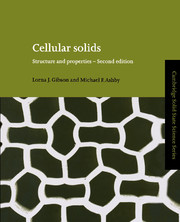Book contents
- Frontmatter
- Contents
- Preface to the second edition
- Preface to the first edition
- Units and conversion tables
- Chapter 1 Introduction
- Chapter 2 The structure of cellular solids
- Chapter 3 Material properties
- Chapter 4 The mechanics of honeycombs
- Chapter 5 The mechanics of foams: basic results
- Chapter 6 The mechanics of foams: refinements
- Chapter 7 Thermal, electrical and acoustic properties of foams
- Chapter 8 Energy absorption in cellular materials
- Chapter 9 The design of sandwich panels with foam cores
- Chapter 10 Wood
- Chapter 11 Cancellous bone
- Chapter 12 Cork
- Chapter 13 Sources, suppliers and property data
- Appendix: The linear-elasticity of anisotropic cellular solids
- Index
- References
Chapter 8 - Energy absorption in cellular materials
Published online by Cambridge University Press: 05 August 2014
- Frontmatter
- Contents
- Preface to the second edition
- Preface to the first edition
- Units and conversion tables
- Chapter 1 Introduction
- Chapter 2 The structure of cellular solids
- Chapter 3 Material properties
- Chapter 4 The mechanics of honeycombs
- Chapter 5 The mechanics of foams: basic results
- Chapter 6 The mechanics of foams: refinements
- Chapter 7 Thermal, electrical and acoustic properties of foams
- Chapter 8 Energy absorption in cellular materials
- Chapter 9 The design of sandwich panels with foam cores
- Chapter 10 Wood
- Chapter 11 Cancellous bone
- Chapter 12 Cork
- Chapter 13 Sources, suppliers and property data
- Appendix: The linear-elasticity of anisotropic cellular solids
- Index
- References
Summary
Introduction and synopsis
Packaging surrounds most things we buy or do. Food is packaged, parcels through the post are packaged, and within a car or aeroplane, we ourselves are carefully packaged. It is hard to say how much is spent on it, or the worth of the goods damaged due to inadequate packaging, but the sums involved are certainly considerable, and the potential return on any improvement is large.
The essence of protective packaging is the ability to convert kinetic energy into energy of some other sort – usually, heat – via plasticity, viscosity, visco-elasticity or friction; and this must be done whilst keeping the peak force (and thus the deceleration or acceleration) on the packaged object below the threshold which will cause damage or injury. And there is more to it than that. The direction of impact may not be predictable; then the package must offer omni-directional protection, that is, it must absorb impact from any side. Since the package must be carried with the object it protects, light weight is important. And – since much packaging is discarded – it must (almost always) be cheap.
Foams are especially good at this. The energy-absorbing capacity of a foam is compared with that of the solid of which it is made in Fig. 8.1. For the same energy-absorption, the foam always generates a lower peak force. Energy is absorbed as the cell walls bend plastically, or buckle, or fracture (depending on the material of which the foam is made), but the stress is limited by the long, flat plateau of the stress-strain curve (Figs. 4.2 and 5.1).
- Type
- Chapter
- Information
- Cellular SolidsStructure and Properties, pp. 309 - 344Publisher: Cambridge University PressPrint publication year: 1997
References
- 15
- Cited by



